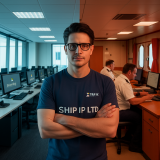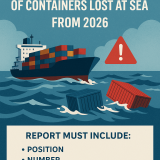When compared to other major river navigation routes around the world, the St. Lawrence River is a favoured waterway.
It flows from the mouth of Lake Ontario, at an altitude of 250 metres. From its source to the Gulf, the river travels 1,197 kilometres, and is fed by several tributaries including the Ottawa, Richelieu, Saint-Francois and Saguenay rivers.
But the effects of climate change are being felt. The marine industry is adapting. It is currently embarking on a shift towards smart technologies in view of this energy transition toward decarbonization.
In this article we will see how the maritime and port industries are integrating climate change into their business models and introducing different adaptive measures.
A professor emeritus of geography at the Universite de Montreal, I am an academic advisor at the Montreal Port Authority. I have been interested in maritime transportation issues for 30 years.
Intelligent communication
Commercial marine navigation on the St. Lawrence is affected by several conditions: variations in water levels related to seasonal cyclical changes, uneven precipitation, ice movement on the river surface, temperature variations and changes in tributary inflow and other anthropogenic factors.
In this system, the transition zone between salt and fresh water starts east of Ile d’Orleans. Water with a higher salt concentration has a higher density than freshwater, and ships sink deeper.
This means that the navigation routes must be maintained and equipped with fixed and floating aids (lighthouses, range lights, buoys, etc.) The Canadian Hydrographic Service monitors tides and water levels, produces charts and collects data to develop programs for safe and sustainable use of the waterway.
Navigation support includes a telecommunications system between ships and the banks of the river. As the St. Lawrence is particularly difficult to navigate, the services of river pilots is necessary to ensure the safety and security of vessels from around the world. Open to winter ocean navigation, the Coast Guard maintains a fleet of icebreakers to keep ships moving.
The impacts of climate change
The scientific literature confirms that maritime transport, port systems and supply chains are influenced by the combined action of climate change and various forms of human intervention.
Climate change is primarily evident in higher air temperatures that affect water levels, precipitation, ice conditions and storms. These can increase the vulnerability of the St. Lawrence river-sea transportation chain as well as the cost of Quebec’s participation in international trade.
Here’s how the maritime and port industry is responding and adapting to these new circumstances.
1) Extreme temperatures
Extreme hot temperatures lead to a slowdown in labour productivity and a reduction in outdoor working hours. This results in longer docked ship hours, consequent delays in operations and more ships on standby.
In addition, high temperatures have an impact on port facilities. Machinery is more likely to break down and there are higher energy costs for ventilation and air conditioning.
Rising temperatures can also increase the vulnerability of marine environments to storms and wave levels. Storms have a direct impact on the scheduling of navigation routes on the St. Lawrence.
Solutions: Some innovations are using intelligent navigation to reduce the vulnerability of commercial shipping to extreme variations in temperature (extreme cold and heat), fluctuating water levels (low water and flooding), and changes in wind strength and direction.
Intelligent navigation is based on interconnectivity between information systems. Navigation assistance (digitization of the seabed, augmented and mixed reality for piloting and physical repairs at sea) makes it possible to limit the risk of incidents and accidents on the river or in the shipping channel.
To ensure the safe mooring of ships at berth during high winds or extreme weather, port authorities are strengthening mooring bollards to prevent breakage. In addition, St. Lawrence ports have adopted delay forecasting plans for docking and unloading cargo to limit wait times at the port during severe weather conditions.
2) Water fluctuation
Considering that the St. Lawrence system allows access to large ships, water levels pose a greater problem than elsewhere.
However, climate change is exacerbating access problems in all the river ports. Changes in water depth not only affect their capacity, but also their reliability, a key factor in shipping traffic development.
Global warming heralds shorter, warmer winters, with more mild weather and rainy spells. Heavy rainfall can increase shifting sediment and may lead to dredging and maintenance of access channels.
This could cause severe flooding of wharfs and port handling areas due to coastal overflows and surface rainwater drainage problems. Extensive flooding could also damage surveillance equipment and compromise port security.
Solutions: During episodes of low water levels, port authorities enhance the safety of all vessels operating on the river system by installing both digital and physical signage indicating the location of current phenomena and shoals.
During intense and extreme rainfall, ports undertake the upgrading of quays and infrastructure. Sediments removed during maintenance dredging can be used to stabilize infrastructure subject to increased erosion or to provide environmental services.
3) Variable ice formation
Freezing is a phenomenon that partly protects the coastline in winter. As the ice dwindles, there will be a potential increase in coastal exposure to strong waves and at the same time, increased shoreline erosion.
Climate change will lead to greater variability in average ice thicknesses and, above all, to a breakdown of ice cover on the St. Lawrence River. In several St. Lawrence ports, this fragmenting could accelerate as ships manoeuver in and out of harbour.
These multiple ice breakages raise serious maritime safety issues, increasing the risk of collision with ships that are forced to slow down.
Solutions: To combat erratic ice formation, the creation of a monitoring service for ice conditions in the river’s waters is a priority measure that is being systematized or strengthened. It provides ships with an accurate navigation tool. The acquisition of tugs equipped with icebreakers operating 24/7 will prevent the accumulation of ice near ports and waterways, thereby increasing the safety of commercial vessels.
Energy transition
Reducing the carbon footprint of the maritime port economy is at the heart of the fight against climate change. Maritime carriers and ports deal with different strategies for managing the energy transition.
Canadian marine carriers such as Fednav, CSL, Groupe Desgagnes Inc, NEAS, Ocean Group, as well as the Societe des traversiers du Quebec and the Canadian Coast Guard, have made investments in: 1) improving their fleets through emission reduction technologies; 2) reducing the speed of ships or 3) using alternative fuels including liquefied natural gas (LNG) and biofuels.
The St. Lawrence ports have also undertaken several initiatives: installing electrical terminals to power ships (Montreal); introducing natural gas as a new ship refuelling service (Montreal, Quebec); lowering port fees for eco-responsible shipowners (Quebec); installing new loading equipment to reduce waiting times for ships (Sept-Iles); funding ecological projects and innovations (Trois-Rivieres); developing circular economy projects (Becancour); installing electric conveyors (Saguenay).
This ongoing energy transition requires the development of renewable energy production tools, a search for efficiency gains, a reduction in consumption and an increase in interconnections to facilitate trade.
This structural transformation of energy production and consumption methods requires major investments, introduction of innovations and a strong political will. In this context, the Quebec maritime and port industry’s actions are part of international best practices in energy transition.
Claude Comtois has received funding from several federal and provincial departments (Transport Canada, Ministere des Transports du Quebec, Ministere de l’Economie, de l’Innovation et des Exportations), the Social Sciences and Humanities Research Council of Canada (SSHRC), the Fonds de recherche du Quebec – Nature et technologie (FRQNT) and the Reseau Quebec Maritime (RQM).
Source: https://theconversation.com/navigating-climate-change-how-shipping-is-adapting-in-the-st-lawrence-189523







